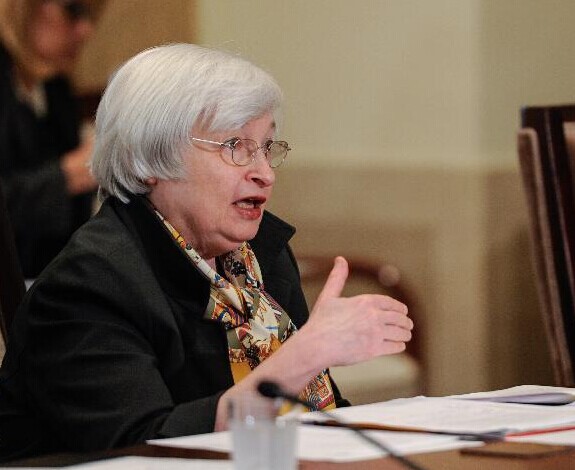

File photo taken on Oct. 22, 2014 shows U.S. Federal Reserve Chair Janet Yellen (L) speaking at an open meeting at the U.S. Federal Reserve in Washington D.C., capital of the United States. The Federal Reserve said Wednesday that it decides to end its monthly asset purchase program, as it sees the economy is improving on track from the worst financial crisis in decades. (Xinhua/Bao Dandan)
The Federal Reserve decided Wednesday to end its six years of pump-priming, as it sees the economy is improving on track from the worst financial crisis in decades. It also pledged to keep low interest rates in the longer run to nurture the hard-earned recovery.
The Fed's monetary policy committee announced the end of the third round of monthly asset purchase program, as it "continues to see sufficient underlying strength in the broader economy to support ongoing progress toward maximum employment in a context of price stability," according to a statement issued after a two-day meeting.
The committee also said it will maintain the low interest rate and its existing policy of reinvesting principal payments from its holdings of agency debt and agency mortgage-backed securities to help maintain accommodative financial conditions.
QE GONE, RATES HIKE NOT IMMINENT
To salvage the world's largest economy from the worst financial meltdown since the "Great Recession," the Fed has kicked off three rounds of quantitative easing (QE) stimulus since the end of 2008, injecting trillions of dollars of liquidity to boost the sagging economy.
The Fed's decision on Wednesday has been expected as it had said it would likely end the program after its October meeting if the economy continued to improve. Since December 2013, it has gradually pared the purchases from 85 billion U.S. dollars in Treasury and mortgage bonds each month to 15 billion dollars.
"QE played a material role in helping to foster the recovery and expansion of the U.S. economy in the past few years," David Stockton, the former Fed chief economist, told Xinhua. It held down long-term interest rates, which in turn boosted consumer spending especially for houses, motor vehicles and other durable goods, he noted.
He said QE also encouraged investors to move into riskier assets such as stocks. "The increase in household wealth from higher stock prices and higher house prices no doubt encouraged greater consumer spending," he added.
The U.S. economy expanded 4.6 percent in the second quarter, as consumer spending posted a strong increase after the chilly winter. Unemployment has fallen to 5.9 percent in September, and inflation keeps low.
With the economy improving, the Fed viewed the accommodative monetary policy still essential to nurture the hard-won economic recovery.
"Even after employment and inflation are near mandate- consistent levels, economic conditions may, for some time, warrant keeping the target federal funds rate below levels the Committee views as normal in the longer run," said the statement.
Mixed signals of job market are top concerns for the Fed on the timing of rates hike. Although the jobless rate declines steadily, the fact that fewer people are willing to enter the workforce has made the Fed confused about the real picture of the job market.
Fed Vice Chairman Stanley Fisher said early this month that weaker-than-expected global economy could prompt the Fed to slow the pace the rates increase, highlighting growing concerns about the impact of global slowdown and a stronger dollar.
Analysts anticipated that the Fed will raise the federal funds rate in the middle of 2015, or even later.
SPILLOVER WARNINGS
As the United States is the world's largest economy and the major reserve currency issuer, its monetary policy adjustment is highly relevant to the rest of the world.
Fed Chair Janet Yellen said that the U.S. central bank is not trying to cause harmful spillovers when it carries out monetary policy, as it certainly strives to avoid harm in generating spillovers when using monetary policy.
After the Fed signaled the exit from the QE in May last year, emerging markets have experienced rounds of capital outflows as investors poured cash back to the United States for higher returns. Interest rates hike in the future is likely to cause similar turmoil to the emerging market.
Stockton said that the spillovers from the removal of Fed accommodation will have different effects on different emerging market economies.
"For China, the spillovers are likely to relatively minimal, as China has little dependence on foreign capital inflows. But for other emerging market economies, the spillovers may prove more painful," he said.
"Investors around the world should prepare for a period of heightened volatility as the Fed begins to normalize policy. Even if the Fed is ultimately successful, there are likely too many bumps along the path to normalization," he added.
Zhu Guangyao, China's vice minister of finance, said early this month that it is particularly important for the Fed to clearly communicate with the market, adding that central banks around the world should stay vigilant against any Fed policy adjustment.
Copyright ©1999-2018
Chinanews.com. All rights reserved.
Reproduction in whole or in part without permission is prohibited.